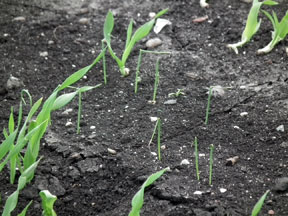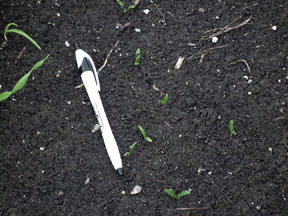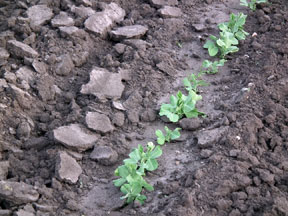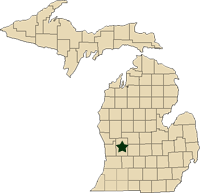Grand Rapids area vegetable update
Field work is progressing rapidly as warmer and drier weather continues.
|
Warmer, drier weather was most welcomed this past week, with field work progressing rapidly. Rainfall was less than a tenth of an inch in most locations. Most readers will recall that 2009 was very cool. This year is much more so. Heat accumulation from Newaygo to Van Buren County, as measured by base-50 growing degree days, is only about two-thirds of 2009, and only half of the 2006-2010 average! Current accumulations range from 110 at Fremont to 270 at Grand Junction. The five-year averages for these locations are 250 GDD and 315 GDD respectively
Onion planting is finally nearing completion, with the northern locations being most delayed by cold, wet weather. In many fields, emergence has not yet occurred, or seedlings are small, in the loop or flag stages (Photo 1). Some growers are concerned that soil crusting may reduce emergence. In other areas, growth is a bit more advanced, with the grower preparing to kill the barley companion crop.

Photo 1. Onion Seedlings at flag stage with barley companion crop.
Celery transplanting continues. Many have accelerated their daily acreage and have caught up, or nearly so. Some have been delayed to a greater extent, with only 10 percent of the crop in the ground. Throughout west Michigan, I estimate 25 percent has been transplanted.
Carrot planting is nearly two weeks behind normal, with only 15 percent of the crop in the ground.
Cabbage transplanting continues. The crop has responded well to the warmer weather.
Parsnips and red beets have been planted, with some emerging (Photo 2).

Photo 2. Parsnips newly emerged.
Radish, lettuce and peas look good (see photos).


Left: Photo 3. Radish fields look good. Right: Photo 4. Young peas – note soil crust broken up by cultivation.
Sweet corn planting is moving ahead at a brisk pace, with growers trying to make up for earlier delays.



 Print
Print Email
Email



